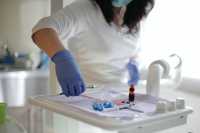
08 Feb Technology That Changed Pediatric Nursing Forever
Pediatric nurses and practitioners deliver care and protection to children through oncology, critical care, and education. As practitioners, it is a PNP’s (pediatric nurse practitioner) responsibility to improve the treatment outcomes for children, as well as to enhance the pediatric service as a whole. They play an integral role in professional development as well as in educating children and families about wellness and health interventions.
To make this – as well as other nursing roles – easier, technological advancements are always being sought after. Below are some that have changed pediatric nursing forever.
Online learning
With the advancement of technology comes new learning options for nurses around the world. Whether that’s small courses to improve their skills while on the job or nursing programs to start a specialist career, subjects can now be studied online.
Online nursing courses are now available by some of the best colleges, and with the help of new technology, changing your specialism has never been easier. If you’re interested in becoming a PNP Nurse, Midwife, or Nurse Executive, there are plenty of flexible options available that allow you to continue providing care to your patients while gaining new qualifications.
ECMO
ECMO – Extracorporeal membrane oxygenation has given children a second chance at life time and time again. Chief Intelligence and Innovation Office of the Children’s Hospital of Orange County says ECMO is in the top 5 ‘singular most impactful innovations incorporating technology’.
ECMO machinery takes over the work of the lungs and sometimes the heart to bring children back to life while on the verge of not surviving.
Electronic Medical Records
By bringing medical records into the digital era, PNPs can provide a better quality of care in whichever health facility the patient walks into. Doctors and nurses can now access previous medical history, past prescriptions, and other diagnoses on an online platform – making care more streamlined for everyone involved.
Stem Cell Transplants
Stem cells are unassigned cells in the body that can turn into different types of cells depending on the requirement – for example, skin cells, liver cells, brain cells. Stem cell transplants have the ability to treat children with complex illnesses such as leukemia, neuroblastoma, auto-immune diseases, and blood disorders.
 Telemedicine
Telemedicine
Using technology to keep in contact, PNPs can now provide care to patients near and far. Telemedicine refers to care that is provided to patients without having to be in the same room. For less complex issues, PNPs can treat patients and provide advice through telephone or video consultation.
Electronic IV Management
In the past, pediatric nurses have been required to be present for the whole IV process. Even the slightest movement by a patient could interrupt the flow of medicine being provided by the IV, and as such, nurses were required to monitor the whole thing. Now, with the use of electronics, IVs can be managed without the nurse being present – giving them more time to care and attend to other patients at the same time.
If something goes wrong, the IV machine will notify the nurse remotely or fix the issue itself.
Portable monitors
Portable monitors allow pediatric nurses to check on their patients while on the move. Monitors show vital signs like ECG, oxygen levels, and respiratory rates. If there is a change or an emergency, the nurse will automatically be alerted. These portable options allow nurses to regularly check in on their patients, rather than sticking to an hourly routine. It also allows the level of care to be higher and more attentive.
3D Printing
Suitable for patients above seven years old, 3D printing can be used to plan complex surgeries and save lives. With this technology, nurses, doctors, and surgeons can streamline treatment plans, boost confidence in the department and provide the best health outcomes for children.
Prior to 3D printing, surgeons relied on X rays and sketches to plan for operating on children. Now, the process is much easier to plan, and results have a higher level of accuracy and confidence.
Big Data
With more focus on evidence-based medicine within the pediatric market, big data has provided thousands of children with better care and wellness plans best suited to their personal needs. By sharing data from previous operations and studies, PNPs have access to a huge source of up-to-date information to help diagnose and plan treatment faster than ever.
Smart Pills
give PNPs the ability to monitor prescription compliance, as well as tracking any changes in a child’s health while at home. Smart pills are prescribed medication that has a tiny, built-in sensor. This sensor signals to a patch worn on the patient’s body so that information can be transferred from patient to practitioner via the computer.
The technology allows pediatricians to monitor heart rate, sleep, and physical activity to help specialists plan the best options for children and adults alike.
Surfactant
Surfactant is a molecule that can be sprayed into the lungs of premature babies. This helps them breathe while also giving the lungs the chance to grow. Newborn, premature babies are likely to die without this treatment.
Robot Phlebotomists
Veebot is the world’s first robot phlebotomist that helps nurses find an appropriate vein to draw blood from, the first time. This is particularly beneficial for PNPs as needles and injections are a stressful procedure for kids – and adults alike! Being able to accurately find a vein prevents pain, frustration and saves time – for both practitioners and patients.
Smartphone Stethoscopes
A visit to the doctors or hospital can be incredibly scary for children. Traditional stethoscopes are intimidating and feel more serious, whereas a smartphone is familiar. Smartphone stethoscope apps allow PNPs to get breathing sounds and heart rates with their phone – meaning they can attend to patients just about anywhere. This is also helpful for any nurse that finds themselves at the scene of an emergency during their time off.
The world of technology has improved a huge range of industries, but one of the most important is healthcare. The latest advancements are working to improve care and safety within the industry as well as speeding up processes and making health advice accessible for everyone.
[subscribe]
[last-modified]
The information on MedicalResearch.com is provided for educational purposes only, and is in no way intended to diagnose, cure, or treat any medical or other condition. Always seek the advice of your physician or other qualified health and ask your doctor any questions you may have regarding a medical condition. In addition to all other limitations and disclaimers in this agreement, service provider and its third party providers disclaim any liability or loss in connection with the content provided on this website.
Last Updated on February 9, 2021 by Marie Benz MD FAAD

 Telemedicine
Telemedicine